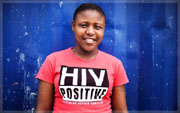-
(单词翻译:双击或拖选)
UNAIDS: 2011 Game Changing Year
The new report from UNAIDS says 2011 brought unprecedented1 progress in science, political leadership and results. It says despite the financial crisis, greater access to HIV treatment had a dramatic effect on the lives of millions of people.
The Joint2 United Nations Program on HIV/AIDS calls 2011 a “game changing year.” Its new report is called How to get to Zero: Faster, Smarter, Better. It says both HIV infections and AIDS-related deaths “have fallen to the lowest levels since the peak of the epidemic3.”
“Faster, smarter, better reflects our desire for reducing the HIV epidemic and also reducing to the maximum possible the damage that it is doing. We build on the success stories that we pick up from different places in the world to show those as examples so that other countries could follow them,” said Peter Ghys is UNAIDS chief epidemiologist.
The UNAIDS report says new infections are down 21 percent since 1997 and AIDS-related deaths have fallen 21 percent since 2005.
Several reasons for the decline
“Close to half of all people who need treatment are currently accessing that treatment. So this comes to about 6.6 million people. Some of the same drugs are also use to reduce mother to child transmission. So that’s another area where we are seeing favorable trends,” said Ghys.
 |
| Nandi Makhele, 25, poses for a portrait while wearing a T-shirt indicating that she is HIV-positive, in Cape4 Town's Khayelitsha township February 15, 2010. Some 5.6 million people live with HIV/AIDS in South Africa - more than in any other country. |
In all, it’s estimated more 14 million people are eligible5 for treatment.
Africa remains6 the hardest hit by the epidemic. The report says 68 percent of all people living with HIV/AIDS are in sub-Saharan Africa. And the region accounts for 70 percent of all new infections. South Africa continues to have more people living with HIV/AIDS than any other country, with 5.6 million.
Despite those figures, Ghys said there is good news for sub-Saharan Africa.
“First of all, it is the epicenter of the epidemic. It is the region that is most affected7. But it is also a region where we have quite a few good examples of favorable trends. So, this is true in the area of treatment where a lot of progress has been made,” he said.
There are also favorable trends among African youth, such as having fewer sexual partners and a greater use of condoms.
Do what works
In these times of tight budgets and spending cuts among donors8, UNAIDS has come up with what’s called an investment framework. The goal is to target those areas that are most successful. This includes anti-retroviral treatment and prevention of mother to child transmission of HIV.
The International HIV/AIDS Alliance calls the report encouraging.
“For the first time we have seen the tremendous result of a collective effort paying off,” said Dr. Gitau Mburu, the alliance’s senior adviser9 on HIV. The collective effort includes governments, civil society, communities, scientists and healthcare workers.
Mburu said the UNAIDS report shows that prevention has taken root in some areas.
“It has shown that in a number of countries in sub-Saharan Africa, a few have them have been able to reach the universal access for HIV treatment, including such countries as Botswana and Namibia. We are therefore very encouraged to see that amid the current levels of funding for HIV response that there is some hope for us to see that there is good outcome at the end of the day,” he said.
However, Mburu agrees with the report that stigma10 and discrimination continue to be obstacles to ending the epidemic.
“A gay man in Uganda right now cannot be able to go to a doctor to seek an HIV test and disclose that he is a man who has sex another man because of laws that criminalize such populations. And we do know that in m many parts of Asia, as well, that sexworkers who are at risk of HIV infection also face a lot of barriers in terms of being arrested and bad policing policies, which make it very difficult for these kind of marginalize populations to see proper HIV prevention interventions,” he said.
The International HIV/AIDS Alliance calls for continued funding of programs that are proven to work. It warns that a reduction could put progress that’s been made at risk.
At the end of 2010, between 31 million and 35 million people were believed living with HIV/AIDS. There were about 2.7 million new infections and 1.8 million people who died of HIV/AIDS-related illnesses.
 收听单词发音
收听单词发音
1
unprecedented

|
|
| adj.无前例的,新奇的 | |
参考例句: |
|
|
|
2
joint

|
|
| adj.联合的,共同的;n.关节,接合处;v.连接,贴合 | |
参考例句: |
|
|
|
3
epidemic

|
|
| n.流行病;盛行;adj.流行性的,流传极广的 | |
参考例句: |
|
|
|
4
cape

|
|
| n.海角,岬;披肩,短披风 | |
参考例句: |
|
|
|
5
eligible

|
|
| adj.有条件被选中的;(尤指婚姻等)合适(意)的 | |
参考例句: |
|
|
|
6
remains

|
|
| n.剩余物,残留物;遗体,遗迹 | |
参考例句: |
|
|
|
7
affected

|
|
| adj.不自然的,假装的 | |
参考例句: |
|
|
|
8
donors

|
|
| n.捐赠者( donor的名词复数 );献血者;捐血者;器官捐献者 | |
参考例句: |
|
|
|
9
adviser

|
|
| n.劝告者,顾问 | |
参考例句: |
|
|
|
10
stigma

|
|
| n.耻辱,污名;(花的)柱头 | |
参考例句: |
|
|
|















